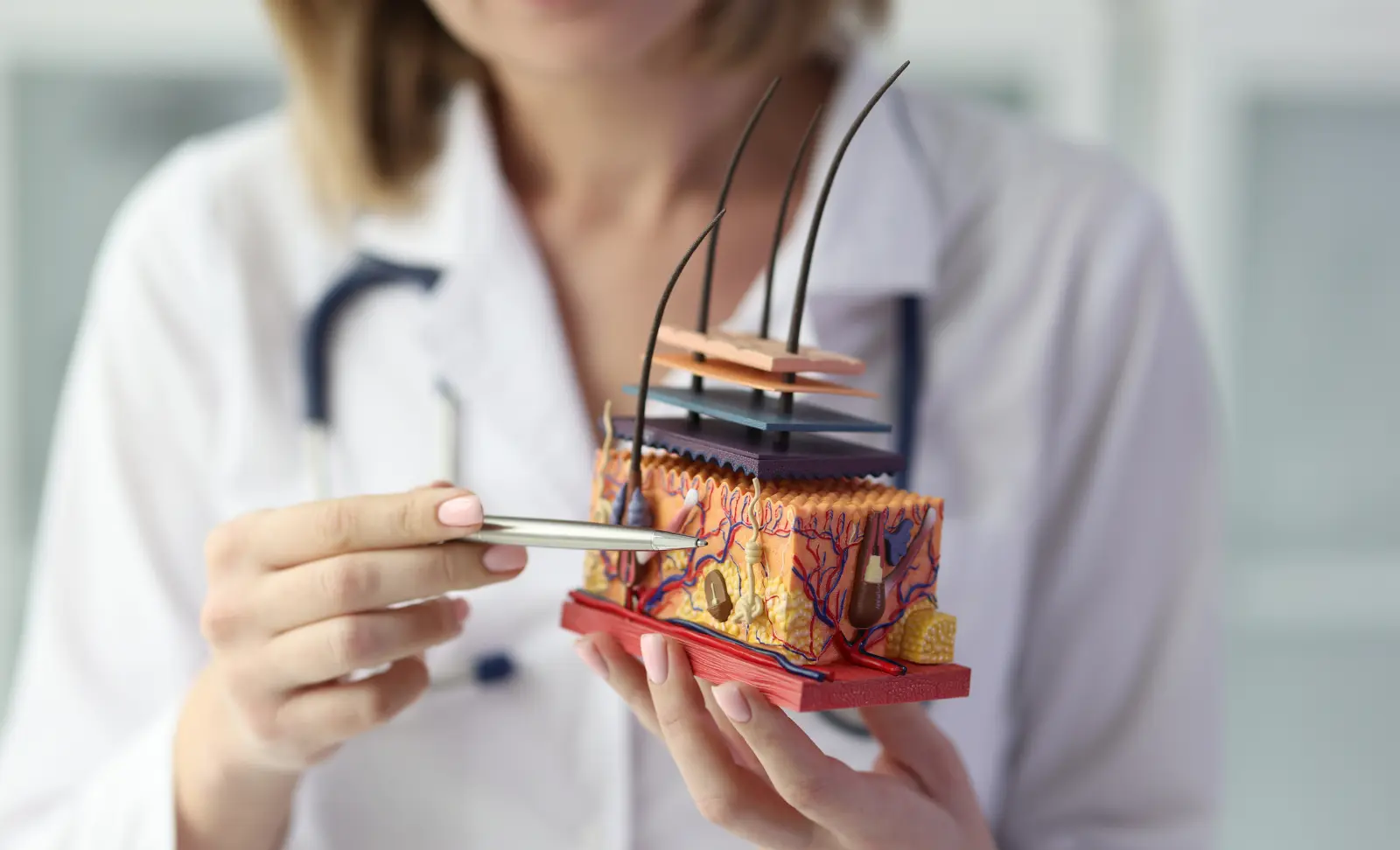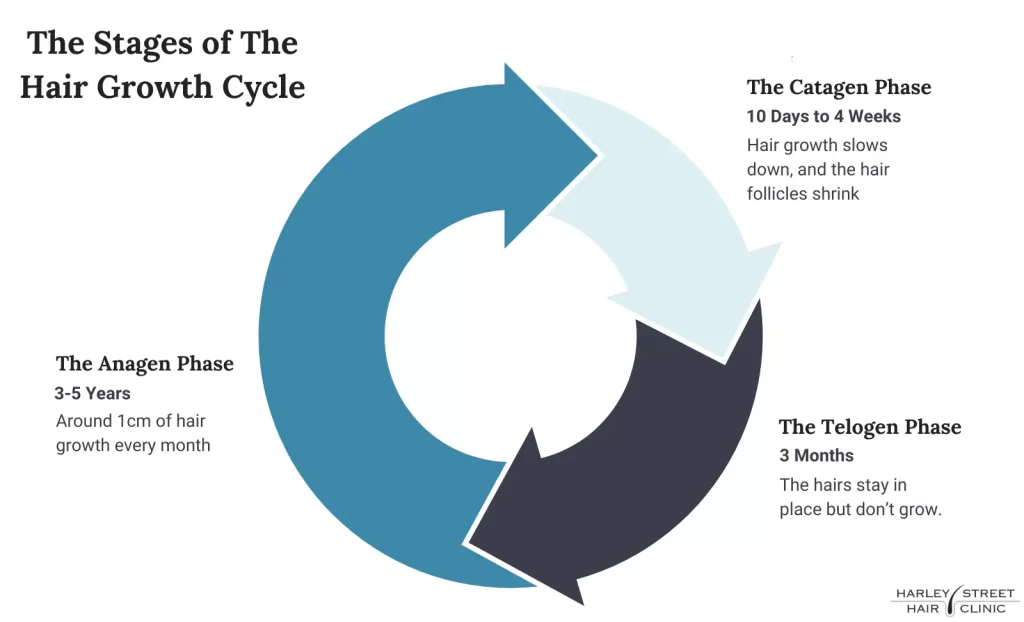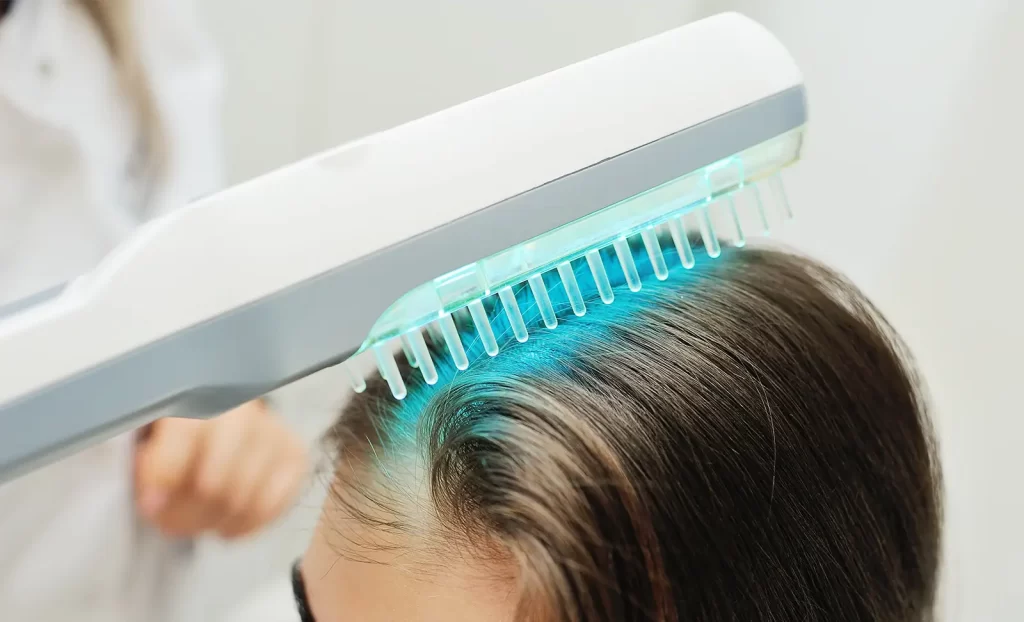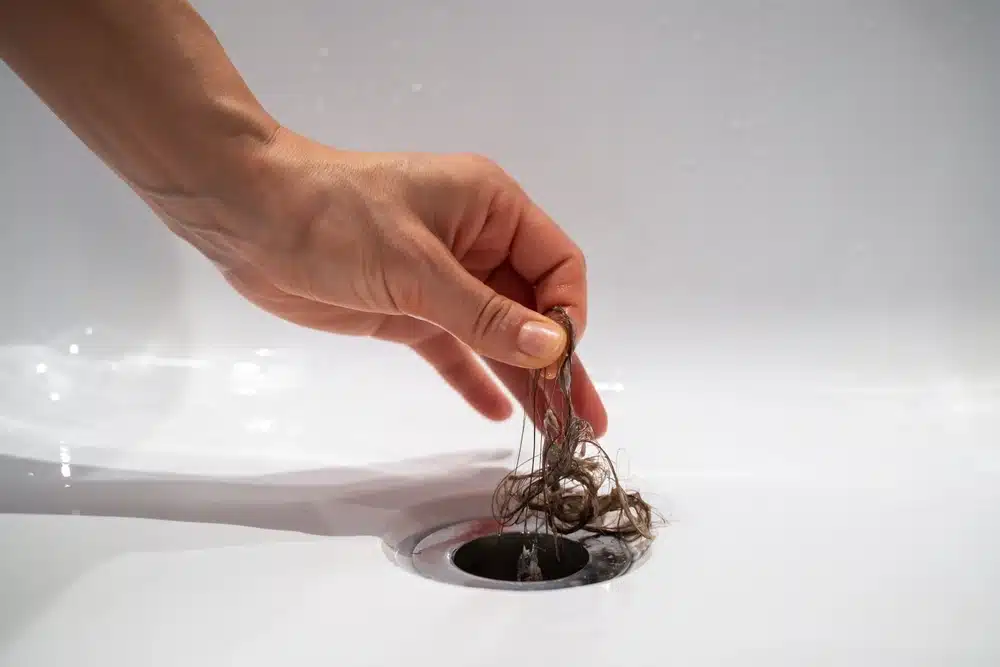Most people have heard about the hair growth cycle before, but many don’t know what it actually is. You might know that your hair goes through a cycle of growing and shedding, but what’s actually happening there, and how long does it take?
This topic may be especially interesting to those who have experienced hair loss. By understanding the hair cycle, you have a better grasp of your own hair and why you may be losing it.
The Stages of the Hair Growth Cycle
Simply put, healthy hair growth is made up of three distinct phases, going from growth to fallout. It includes the Anagen, Catagen, and Telogen phases [1], which we’ll go into more detail below.
The Anagen Phase
The anagen stage is also known as the growing phase. It begins the cycle when the hair continuously grows while the hair follicles stay attached to the scalp. During this time, the hair grows continuously, with most people seeing around 1cm of growth every month. It’s the longest of the stages, lasting between three and five years for the average person – although some people have genetics that result in the anagen stage lasting for much longer, even up to seven years! They’re the people who can seem to grow very long hair.
The anagen growth phase makes up most of the hairs on your head. In fact, 90% [2] of people’s scalp hairs are in the anagen phase at any time.
The Catagen Phase
Once the anagen phase ends, the catagen stage begins, known as the transition phase. At this stage, hair growth slows down, and the hair follicles shrink. It can last anywhere from ten days to four weeks, and during this time, the hair degrades. At any given time, 3% of your scalp hair is in this stage.
The Telogen Phase
Finally, there’s the telogen stage, also known as the resting phase. As the name suggests, this is when the hairs stay in place but don’t grow. At the end of the telogen resting phase, the hair tends to fall out, which is why it’s normal for people to lose around 100 hairs per day. [3]
Your hair stays in the telogen phase for around three months. At any given time, 10-15% of your scalp’s hair is in the telogen phase.
What About the Exogen Phase?
The cycle is often split into three parts, with the telogen and exogen phases being conflated most of the time. However, some scientists distinguish the exogen phase, often known as the shedding stage. This is the end of the telogen phase when the hair sheds before new growth can come through. So, you can view the growth cycle as follows: anagen, catagen, telogen, exogen – or, you can mix telogen and exogen together.
Why is Knowing About the Hair Growth Important?
Many people can go through life without ever thinking about hair growth; to them, their hair grows consistently, with only a little fallout.
For some, knowing about the hair cycle simply scratches that itch of curiosity – it’s fun to know about the processes that happen within your body! For others, it’s more important than that; for those who have experienced hair loss, understanding the hair growth cycle may help them understand why it’s happened. A hair track app can deepen that understanding, allowing you to track hair loss and growth over a long period of time.
Is the Growth Cycle the Same for Everyone?
There are some definite variables from person to person. For example, the anagen phase may last just three years in some people but seven years in others. That’s a big difference! It’s natural and usually due to genetics. There’s a reason some people have an easier time growing long hair compared to others.
Of course, there are also cases where the growth cycle is disrupted. In these cases, the person will often experience hair loss, which a variety of factors can cause.
What Causes Disruptions to Hair Growth?
So, what happens when the hair doesn’t go through each stage properly? Sometimes, the hair sheds sooner than it should, leading to hair loss. This can be devastating for individuals, especially considering that hair is often closely tied to confidence and identity.
Stress
Did you know stress can disrupt the cycle of hair growth? It’s true. When the body produces too much stress, it can lead to telogen effluvium, which is when the hair reaches the telogen/shedding phase too quickly. It’s usually an acute condition in which patients are able to regrow their hair again after a couple of months, but a hair loss treatment may be necessary.
Age
Your body changes significantly as you age, including the hair. Many people go through female or male pattern hair loss, which is when the hair starts to fall out in some regions of the scalp (for men, this is usually at the temples or the crown of the head).
Genetics
Genetics play a huge role in how much hair you have. Some people are more prone to things like male pattern baldness, which results in their hair falling out. There are some ways to reverse the signs of genetic hair loss, which we’ll go into a little further down.
A Poor Diet
Eating a poor diet without the essential vitamins and minerals can lead to hair loss. For example, not getting enough nutrients can lead to acute telogen effluvium [4], a common occurrence in people who restrict their food intake. Deficiencies in biotin, vitamin B12, folate, and riboflavin are particularly known for causing the hair to fall out. [5]
Certain Health Conditions
Some hair conditions disrupt the growth cycle of hair. One example is an underactive or overactive thyroid, which can cause the hair to shed. Other conditions include alopecia areata, certain cancers, trichotillomania, and some autoimmune disorders.
Keeping Your Hair Healthy
Your goal here is to keep your hair in a healthy hair cycle, which means avoiding the things that cause fallout. Here are some ways to do just that.
Eat a Well-balanced, Nutritious Diet
Getting all the essential nutrients means you’re far less likely to experience hair loss. If you are restricting calories for weight loss, it’s important to also ensure you’re getting enough vitamins and minerals to keep your body healthy and prevent your hair from falling out. A highly restrictive diet is not a good idea.
Lower Stress Levels
It’s easier said than done, but lowering your stress levels is essential to healthy hair (not to mention a healthy body and mind overall!). The best way to do that is to locate the biggest causes of your stress and try to avoid them. If you find stress becomes overwhelming, see your doctor.
Treat Your Hair Well
Your hair will not thank you for excessive chemicals and the overuse of heat. Treating your hair well is paramount if you want long, healthy locks. Avoid bleaching or dyeing your hair too much, and always use heat protection when styling. Good hair products like hair oils are also good for keeping your hair shiny and luscious.
Hair Restoration Options
So, you’ve spent all your time and energy on achieving healthy hair, only to still experience hair loss. What next? The good news is that there are effective hair restoration options out there.
Minoxidil
One of the most sought-after hair loss medications on the market is minoxidil, also often known by its brand name, Rogaine. Minoxidil is a pretty effective and easy-to-use hair loss treatment for both women and men, producing results for many in a matter of months. You can get it over the counter but must take it continuously to keep up with the results.
Finasteride
Finasteride is another medication for hair growth. This one is taken only by men and can only be attained through a prescription. It’s typically an oral medication that reduces the hormone DHT, which can help men regrow their hair.
Low-level Light Therapy
Low-level light therapy is a relatively simple hair restoration option that uses light therapy to stimulate the hair follicles and – hopefully – encourage brand-new hair growth. Many people find positive results with it.
Hair Transplants
A hair transplant is another excellent method for restoring the hair. It works by taking healthy hair follicles from one area of the scalp and placing them into another (the space where the patient experiences hair loss). Over time, those transplanted follicles start to grow through the usual healthy hair growth cycle, resulting in a full head of hair. The natural results and permanent nature of the procedure make it a popular option.
In Summary
In a healthy person, the hair growth cycle goes through three phases: the anagen phase, the catagen phase, and the telogen phase, which sees the hair go from growth to shedding. Unfortunately, certain circumstances can disrupt these phases and lead to hair loss. On the plus side, there are options for restoring the growth cycle, from eating a nutritious diet to addressing specific health conditions.
Are you considering a hair transplant? If so, you’re in the right place – we have a wealth of information surrounding hair transplants, as well as a patients gallery showing what our top surgeons can do. If you’re interested in a consultation, you can get in touch today!
Sources:
- https://www.ncbi.nlm.nih.gov/pmc/articles/PMC9917549/#:~:text=Hair%20growth%20occurs%20in%20a,in%20a%20lifetime%20%5B2%5D.
- https://www.ncbi.nlm.nih.gov/pmc/articles/PMC5338843/
- https://www.medicalnewstoday.com/articles/327188#:~:text=Hair%20falls%20out%20every%20day,before%20the%20hair%20falls%20out.
- https://www.ncbi.nlm.nih.gov/pmc/articles/PMC5315033/#:~:text=Nutritional%20deficiency%20may%20impact%20both,in%20niacin%20deficiency%20%5B2%5D.
- https://www.ncbi.nlm.nih.gov/pmc/articles/PMC6380979/#:~:text=Only%20riboflavin%2C%20biotin%2C%20folate%2C,(FAD)%20%5B22%5D.




